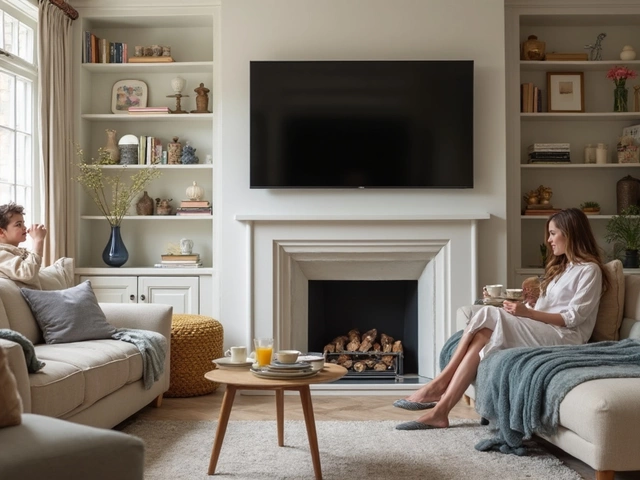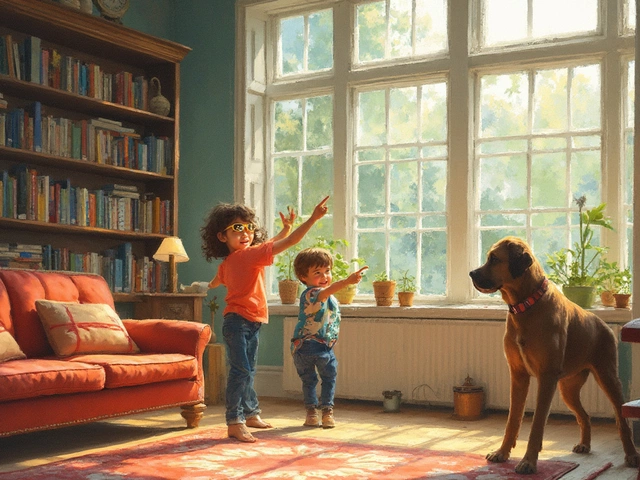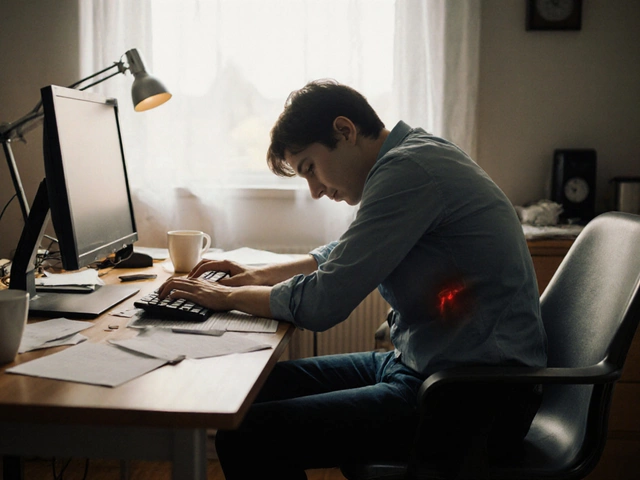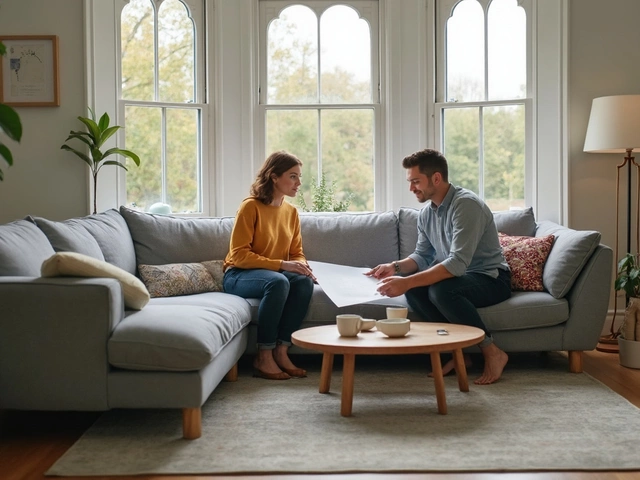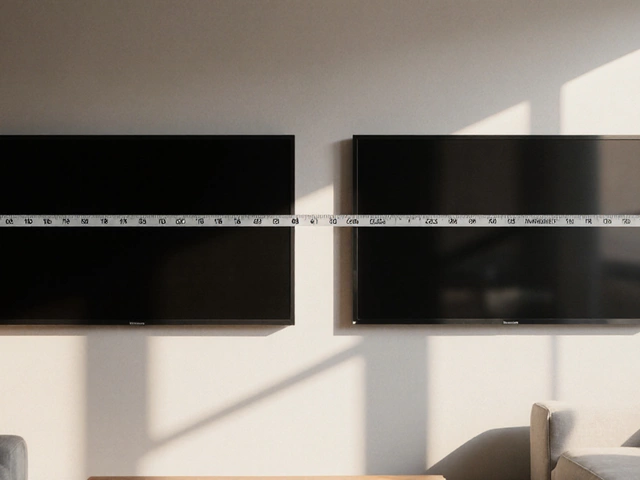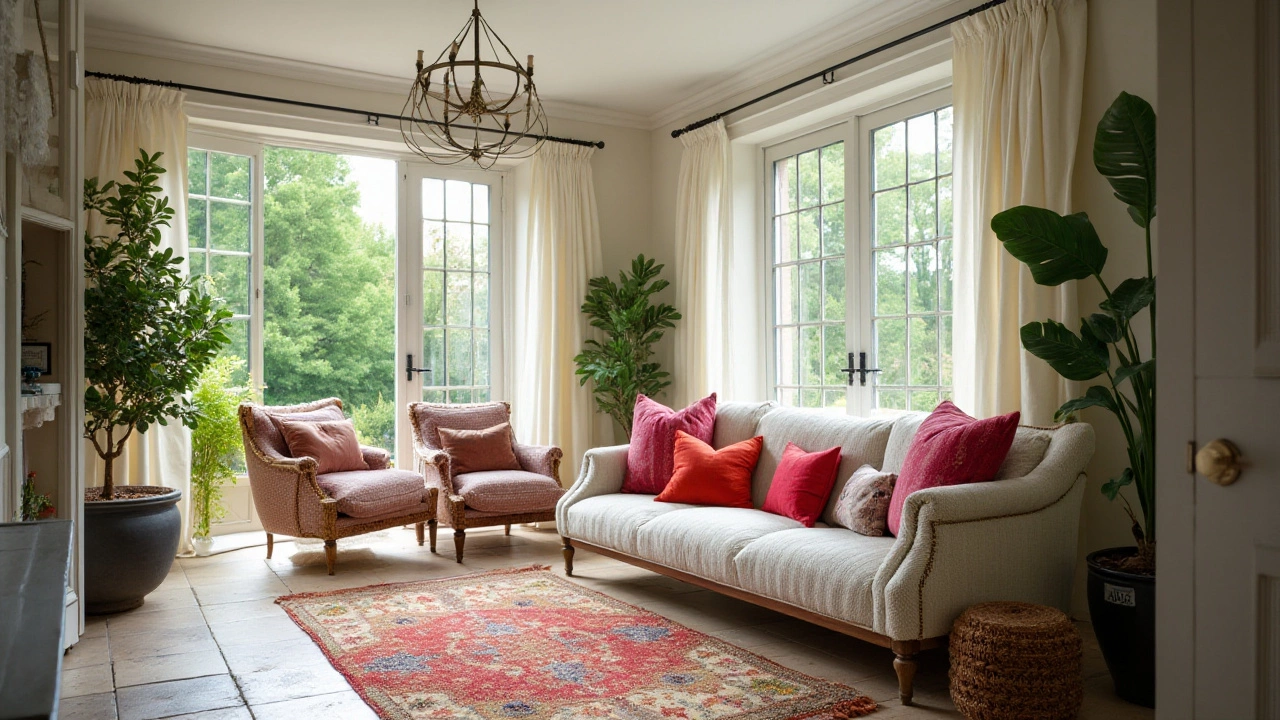 13
Jan,2025
13
Jan,2025
When it comes to home decor, the sofa holds a prime spot in our living rooms, often becoming the heart of the home for gatherings and relaxation. However, where you choose to place your sofa can significantly affect the flow and feel of your space. Surprisingly, a wrong sofa placement can turn a cozy room into a cramped space or cut off natural light, diminishing the overall ambiance.
Getting it right involves considering elements you might not immediately think of, like the paths people take through the room, the location of windows, and the focal points of your decor. With some strategic planning and a touch of creativity, you can maximize the comfort and aesthetic appeal of your living room, making every seat the best seat in the house.
- Understanding Living Room Dynamics
- The Consequences of Blocking Pathways
- Why Avoid Window Placement
- Balancing With Lighting Fixtures
- Impact on Room's Focal Points
- Achieving Optimal Sofa Positioning
Understanding Living Room Dynamics
The living room is often the focal point of the home, a place where style and functionality converge to set the tone for the entire house. To truly understand the dynamics of this space, we need to look at the interplay between various elements that make it an area of comfort and utility. It's not simply about placing a sofa where it fits or looks good; instead, it's about crafting an environment where furniture placement reflects natural light patterns, architectural features, and interior pathways. The first step toward achieving this balance is taking stock of what you already have and how the room functions daily.
Imagine a room where the natural light flow is obstructed by a hastily positioned sofa. This often leads to rooms feeling cramped or even stifled, regardless of their size. The dynamics of a living room can be altered by even the smallest spatial decisions. Not just light, but passageways too need careful consideration. Ensuring that movement through the room remains unobstructed keeps the area welcoming and open. A well-placed sofa respects these pathways and aligns with the movement, providing both accessibility and aesthetic appeal.
Moreover, balancing the room involves understanding its various focal points. This might be a fireplace, a lovely set of bay windows, or even an intricate art centerpiece. A strategically placed sofa highlights these features rather than competes with them. Interior design expert William Morris once quipped, "Have nothing in your house that you do not know to be useful, or believe to be beautiful."
William Morris, a renowned designer of his time, emphasizes the importance of thoughtful placement, where both beauty and utility coexist seamlessly.The concept translates well into today’s living room dynamics, ensuring that the placement of every little thing complements the room's core assets.
The art of arrangement is subtle yet significant. The arrangement should facilitate conversation and engagement without compromising comfort. Understanding how different pieces interact with each other can help create a cohesive look. Sometimes, it even involves moving beyond the conventional against-the-wall setup. A sofa doesn't always have to be against a wall; if the room allows, try placing it centrally or at an angle to encourage foot traffic and flow around it.
Interestingly, statistics show that homes with thoughtfully arranged living rooms often have higher perceived value. According to a home design study, homes with an optimized layout using interior design principles can increase their market appeal by up to 15%.
| Layout Optimization | Perceived Value Increase |
|---|---|
| Balanced Arrangements | 10% |
| Enhanced Natural Light Flow | 15% |
In summary, understanding living room dynamics is more than a quick glance at proportions and angles. It’s a detailed study of behavior patterns, aesthetic preferences, and practical requirements all blended into a gracefully functional space. Each living room tells its story, and informed arrangements are the brushes and colors that paint it vividly.
The Consequences of Blocking Pathways
At the heart of a functional living room is its flow; like water, humans navigate these spaces effortlessly—until impediments appear. Placing a sofa where it disrupts these natural pathways can unsettle the harmony of a room. Imagine entering a space where maneuvering around bulky furniture becomes a cumbersome hurdle. Not only does this hinder day-to-day ease, but it can also have subtle psychological effects. Numerous studies have highlighted how our environment affects our stress levels, and cluttered or awkward layouts are often culprits in elevated anxiety.
Blocking paths can interfere with how guests experience your home. First impressions matter: a guest navigating hurdles to find seating may feel less inclined to relax. But it's not just about comfort. Safety is a key concern. In emergency situations, clear pathways are crucial, providing quick and unhindered escape routes. Home designers often reiterate the importance of maintaining at least 30 inches of pathway to ensure both ease of movement and safety.
"A well-laid-out room should invite exploration rather than feel like a maze," remarks interior designer Sarah Richardson. Her observation often rings true in homes where furniture is an afterthought, rather than a thought-out process. Cluttered pathways subtly send out vibes of chaos and can reduce the perceived size of a room, making even the largest spaces feel cramped.
When pathways aren’t considered, the room's purpose can dilute. Think of a living room meant for conversation. A sofa placed where traffic flow is disrupted often leads to people naturally shifting around, pulling chairs or even worse, leaving the room entirely for more comfortable environs. On a more practical level, consistent movement around tightly packed sofas can lead to increased wear and tear on both furniture and flooring, particularly in high-traffic homes.
The solution is simple yet requires thoughtful planning. Begin by identifying major entry and exit points in your living room. Visualize foot traffic, remember common destinations like TVs or windows, and adjust your layout to complement this flow. This strategy not only creates a more harmonious space but often breathes new life into the room's dynamics, allowing your home decor to shine, while accentuating focal points that may otherwise remain unnoticed.
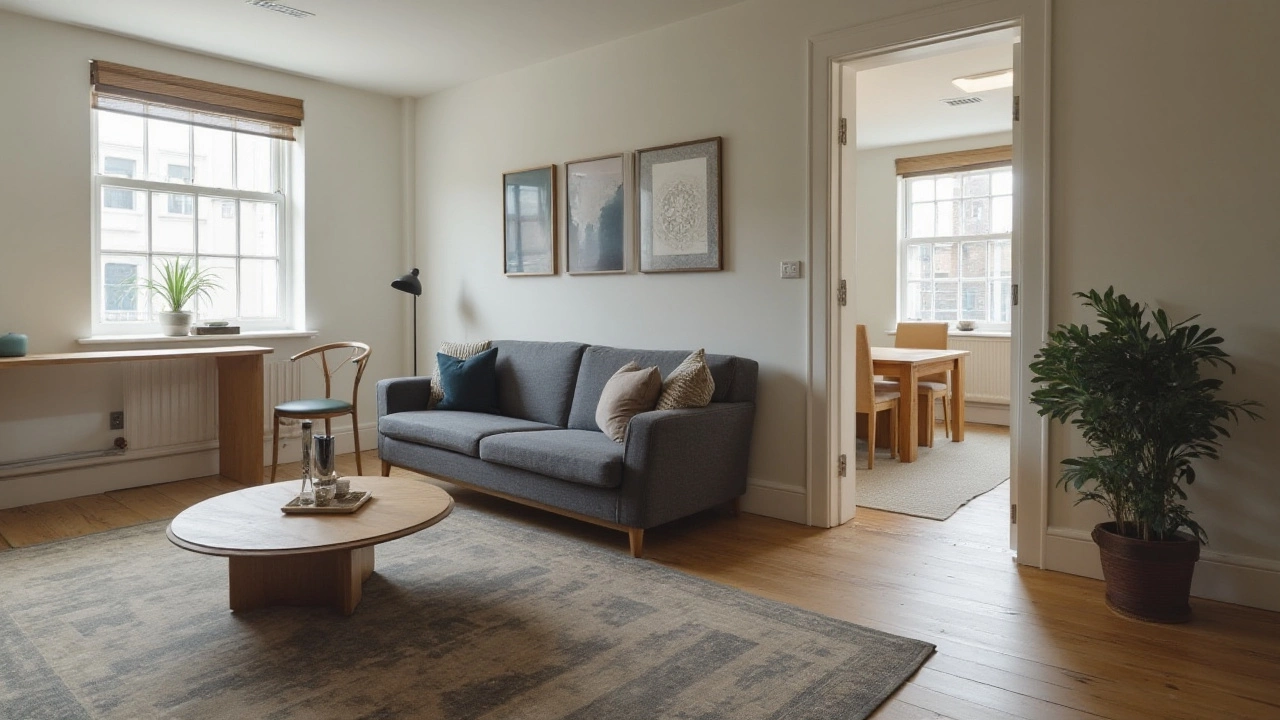
Why Avoid Window Placement
When arranging your living room, a common rookie mistake is placing your sofa in front of a window. While this might seem like a practical solution, particularly if you're trying to work with limited wall space, it can lead to a range of issues that can hamper the functionality and aesthetics of your room. Firstly, blocking natural light could be the biggest drawback of this setup. Melbourne, much like many other places, is blessed with ample sunshine, and obstructing the windows with furniture essentially means cutting off the primary source of natural illumination that can breathe life into any space. By diverting or dimming this natural light, you're likely to end up with a room that feels darker and less inviting, which can affect mood and ambiance detrimentally.
The other concern with positioning your sofa in front of a window is that it might limit the view. If your window opens out to a beautiful garden, a tranquil street, or a stunning skyline, placing a sofa right in front of it means you're blocking these attractive sights. It's like having a masterpiece painting and hanging something else in front to obscure it partially. Additionally, sitting so close to the window can create uncomfortable glare or reflection on your TV screen, especially during the day, making it difficult to enjoy your favorite shows.
Another aspect to consider is the potential damage to the furniture. Prolonged exposure to direct sunlight can fade upholstery fabrics and give them a worn, tired look long before their time. Wood frames and embellishments can also warp or discolor when subjected to continuous sunlight, which is an unwelcomed surprise for many. If you're absolutely set on placing the sofa near the window, you can minimize these effects by selecting fade-resistant fabrics or installing UV-blocking films on your windows. However, it's still advisable to consider alternative placements first to avoid constant worrying.
Heat exposure is yet another factor to be mindful of. In the summer months, the direct sunlight filtering through windows can raise the temperature on the lounger substantially, making it uncomfortable at best and unbearable at worst. This excess heat can also spike your cooling costs, as your air conditioner struggles to keep up with the influx of warmth. Strategically positioning your seating can help mitigate energy expenses and keep your space comfortably cool.
As interior design specialist Sarah Richardson aptly notes,
"The placement of your sofa should prioritize enhancing not just the look but the experience of the space. A well-positioned sofa makes all the difference."Leveraging the room's layout by leaving windows unobstructed allows better air circulation, optimal light exposure, and frames the view as a beautiful focal point. Instead of a window, consider aligning your sofa against a solid wall or using it to create distinct zones within an open-plan setup. You'll find that mindful sofa placement can be transformative, adding to the liveliness and functionality of your home.
Balancing With Lighting Fixtures
Positioning your **sofa** in relation to lighting fixtures is as much about aesthetics as it is about functionality. Lighting plays a critical role in setting the mood and enhancing the visual appeal of your **living room**. The way light interacts with your furniture until dusk can change the entire vibe, creating an inviting space that feels both warm and spacious. Imagine entering a room where the grand **sofa set** is casting long shadows over everything or blocking the soft glow of an elegant lamp. Not quite the atmosphere we're aiming for.
Naturally, we want the **sofa** to be positioned where it feels right, not just for direct sunlight but also for artificial lighting. Consider the primary activities taking place in your **living room**. If it's the spot for cozy evenings with a book, ensure a lamp or overhead fixture provides ample illumination without needing to strain your eyes. On the other hand, for an area meant for socializing, subtle ambient light complemented by accent lighting showcases the elegance of your **interior design**. Remember, darker elements absorb light while lighter shades reflect it. Thus, coordinating colors with your **sofa placement** and light sources can visually expand or contract your space. Using lamps with adjustable brightness levels can also create flexible settings for different occasions.
We can't underestimate the influence of floor and ceiling lighting either. A chandelier or pendant light centered over a misplaced **sofa** can disrupt the room's harmony. Think about the comfort of glancing without an awkward shadow or unbearable glare distracting your view. Keep your lighting versatile. Floor lamps that offer directional lighting can be ideal alongside or behind the **sofa**, granting you command over the room's brightness and serving as a stylistically enhancing feature.
"Lighting is an effortless way to change the mood of a room, especially when it's layered from multiple sources," noted Jessica Ryan, a renowned interior designer known for her ingenious spatial arrangements.Keep in mind that light should complement, not compete with your decor. By thoughtfully balancing your **sofa positioning** with the brilliance of your lighting fixtures, you craft an inviting environment that aligns perfectly with your **home decor** aspirations.

Impact on Room's Focal Points
In any well-designed living room, a focal point serves as the anchor for the surroundings, drawing attention and creating a harmonious balance. Whether it’s a roaring fireplace, an intricate piece of art, or a large flat-screen television, the placement of your sofa in relation to this central element plays a crucial role in the room's design success. The sofa should complement rather than compete with the focal point. An incorrectly placed sofa can unwittingly become a focal point itself, disrupting the intended visual flow of the room.
Consider this: when a television serves as the main attraction, the sofa's position must facilitate a clear and comfortable viewing experience, free from glare, while maintaining a comfortable distance for optimal viewing. Alternatively, if a breathtaking view through large windows is what you wish to highlight, ensure the sofa does not block this natural scene but instead allows it to unfold in its entirety. In artistically-driven spaces, attention must be paid to how the sofa frames or directs attention to the artwork, allowing guests to admire without obstruction.
The strategic positioning of your seating can also enhance architectural features or statement pieces. For example, in a room where a fireplace demands admiration, arranging the sofa to facilitate intimate gatherings around its warmth can drastically improve the room's usability and comfort. This is especially crucial in settings where social interaction is expected and cherished. Moreover, it completes the visual hierarchy, adding depth to the spatial arrangement.
Interestingly, designers often encourage establishing multiple focal points to diversify a room's narrative. In such cases, it's not necessary to have the sofa facing directly towards a single element; instead, angle it to embrace various vistas or functions. This can often provide a dynamic, less rigid feel and make the room appear layered and inviting. The challenge remains in allowing each focal element to maintain its identity without overwhelming the space. In fact, according to a famous principle put forth by the interior design legend Nate Berkus, "A home should tell the story of who you are and be a collection of what you love brought together under one roof."
Nate's perspective underscores the importance of thoughtful placement, as it is not just about aesthetics but about curating a narrative through spatial arrangement.
This is where designing with intention comes into play. Balancing your sofa’s placement around the room’s focal points ensures it feels cohesive, functional, and visually appealing. Emphasizing the role of strategic furniture arrangement in harmony with identified focal elements can transform your living room from a simple lounge space into an experience worth sharing.
Achieving Optimal Sofa Positioning
Perfectly positioning your sofa can make all the difference in transforming a living room from a mere sitting area into a harmonious and inviting space. To start, consider the natural flow of your room - the paths people use when walking from one side to the other. Ensuring that a sofa placement doesn’t interrupt these pathways is crucial, as it maintains the ease of movement and accessibility. This often means considering the architecture and layout of the room itself, which may result in positioning the sofa at a slight angle or further from the wall than might be standard.
The importance of the living room's center or focal point is another significant factor. Whether it's a fireplace, television, or a scenic window view, determine the main feature of the room and orient the sofa in a way that allows for comfortable viewing. This doesn’t just enhance aesthetic appeal but also ensures social interaction comfortably as everyone can face the point of interest. Incorporating corner sofas might be an excellent option for larger rooms, whereas a simpler two-seater might be ideal for more compact spaces.
"Great architecture starts with the careful consideration of furniture," suggests famed interior designer Nate Berkus. Placing a sofa optimally requires far more context and planning than immediately meets the eye.
Next on the list is lighting. Natural light streaming in from windows can be refreshing, so positioning the sofa where it optimally uses this light, without obstructing it, can improve the mood of the room. If natural light is sparse, make sure your sofa placement allows for fixtures like floor lamps or overhead lighting to be effective, ensuring ample lighting is present, avoiding any shadows or unwelcoming dark spots.
Let's not forget the importance of balance in design dynamics. For instance, if your sofa is large and imposing, balance it out with equally weighted furniture pieces or art on the opposite wall. This creates an equilibrium in visual weight across the room, preventing a lopsided feel. In smaller rooms, achieving balance could mean selecting a more compact design and pairing it with tall, narrow bookcases or light fixtures to draw the eye upward, thus preventing the room from feeling cramped.
Tables can provide visual data to see potential gains. Consider a simple analysis:
| Element | Effect on Placement |
|---|---|
| Window View | Improves ambiance, offers natural lighting |
| Curtains or Blinds | Adjust lighting, provide privacy |
| Your Room's Size | Defines furniture arrangement flexibility |
Never underestimate the power of textiles such as cushions or rugs, which can be used to anchor the space or add pops of color that complement your home decor. Play around with textures and patterns to create variety and warmth. Your goal should be a well-curated look that reflects personal style while making the sofa area inviting and versatile for different occasions. By taking these tips and adjusting according to your personal needs and tastes, you’ll find the perfect spot for your sofa, one that enhances both form and function in your home decor endeavors.
